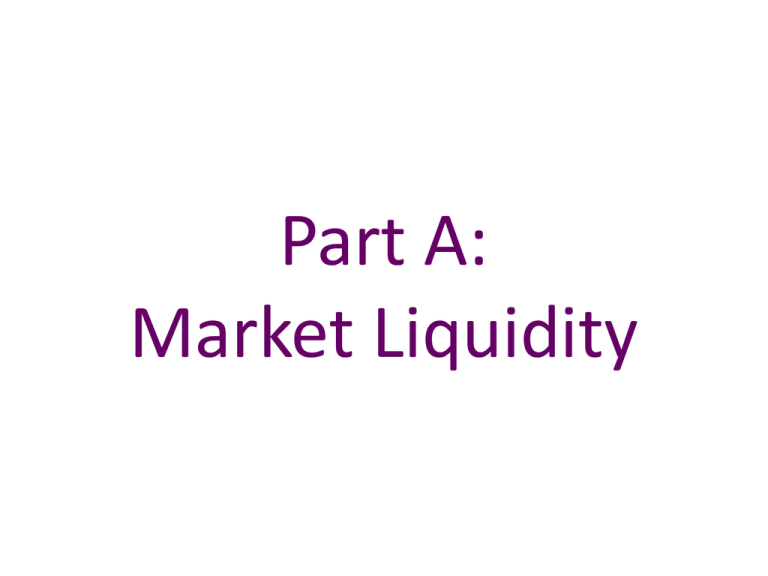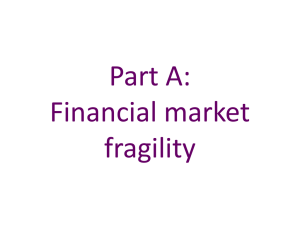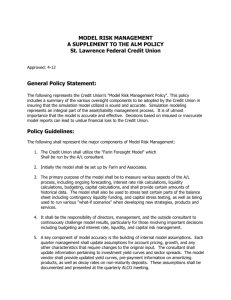Market Liquidity - Bank of England
advertisement

Part A: Market Liquidity Chart A.10 Implied volatilities have increased recently Differences from averages, in standard deviations, of three-month option-implied volatilities(a) Sources: Barclays Live, Bloomberg, Chicago Mercantile Exchange, NYSE Liffe and Bank calculations. (a) Three-month option-implied volatilities for international short (one-year) and long (ten-year) interest rates, equities, exchange rates and commodities. Chart A.11 Episodes of market volatility have increased in frequency and magnitude Intraday moves in Swiss franc and US Treasuries(a) Sources: Bloomberg and Bank calculations. (a) Diamonds show closing index value on relevant day. (b) 15 October 2014. (c) 15 January 2015. Exchange rate ceiling was removed at 9:30 GMT. Chart A.12 There has been a rapid increase in German government bond yields Changes in the 30-year German government bond yield versus US Treasuries in earlier episodes(a)(b) Sources: Bloomberg and Bank calculations. (a) Series show difference, in percentage points, from lowest value over relevant period. (b) Troughs reached on 10 January 1994, 2 May 2013 and 20 April 2015. Chart A.13 Volatility in a number of markets has become more sensitive to news Impact of asset price news on volatility in UK equity/credit markets(a)(b) Sources: BofA Merrill Lynch Global Research, Thomson Reuters Datastream and Bank calculations. (a) Based on exponential GARCH (EGARCH) model, which allows for conditional volatility to react differently to negative and positive shocks to returns. UK equity refers to FTSE All-Share, UK credit to sterling investment-grade corporate bonds. (b) Pre-crisis: Jan. 2001–June 2007. Post-crisis: April 2009–Jan. 2015. Chart A.14 Dealer inventories of corporate securities have fallen with transaction volumes unaffected US primary dealer inventories and transaction volumes(a) Sources: Federal Reserve Bank of New York and Bank calculations. (a) Inventories measured as US primary dealer net positions in US corporate securities, which include corporate bonds, non-agency RMBS and CMBS, with a remaining maturity of at least twelve months. Chart A.15 Corporate bond liquidity risk premia remain below historical averages Deviations of estimated corporate bond liquidity risk premia from historical averages(a)(b) Sources: Bloomberg, BofA Merrill Lynch Global Research, Thomson Reuters Datastream and Bank calculations. (a) Implied liquidity risk premia are estimated using a Merton model as in Leland, H and Toft, K (1996), ‘Optimal capital structure, endogenous bankruptcy, and the term structure of credit spreads’, Journal of Finance, Vol. 51, pages 987–1,019, to decompose corporate bond spreads. (b) Quarterly averages of deviations of implied liquidity risk premia from sample averages. Sample averages are from 1999 Q4 for € investment-grade and 1997 Q1 for £ investment-grade, US$ investment-grade and US$ high-yield. Chart A.16 The difference between high-yield and investment-grade corporate bond spreads has narrowed Difference in spread of high-yield versus investment-grade corporate bonds(a) Sources: BofA Merrill Lynch Global Research and Bank calculations. (a) Option-adjusted spreads. The US dollar series refers to US dollar-denominated bonds issued in the US domestic market, while the sterling and euro series refer to bonds Issued in domestic or eurobond markets in the respective currencies Box 1: Financial Policy Committee work plan on market liquidity Chart A Net finance raised by UK PNFCs(a) Source: Bank of England. (a) Finance raised by PNFCs from UK monetary financial Institutions and from capital markets. Data cover funds raised in both sterling and foreign currency, converted to sterling. Seasonally adjusted. Bonds, equity and commercial paper are non seasonal. (b) Owing to the seasonal adjustment methodology, this series may not equal the sum of its components.





